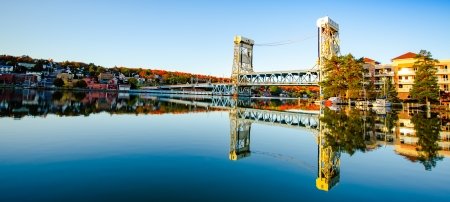Go Big, Play Hard, Michigan Tech Historian Tells Regional Planners
City limits don’t limit much of anything anymore. The issues that really matter in metropolitan areas transcend political boundaries: efficient mass transit, good highways, a safe, clean environment.
Those regional challenges are becoming even more critical in a global economy, since good planning will be key to the economic competitiveness of megaregions like the Northeast, the Texas Triangle and the Great Lakes, says Louise Nelson Dyble, an assistant professor of history at Michigan Technological University.
“To be productive and prosperous, we need efficient, equitable, sustainable metropolitan areas with good infrastructure and appropriate transportation,” she said. “The role of our government should be to manage our resources in a way that results in our success, and to be successful, you need infrastructure that integrates a region.
“However, that infrastructure doesn’t arise on its own,” she said. “Agencies must plan for it.”
But as sensible as regional planning may seem, it is notoriously tough to implement. Its enemies are not usually the people, who stand to benefit from better services and economic growth, but the local agencies and governments that view regional planning as a threat to their sovereignty.
Dyble illustrates her point with a case study drawn from the mid-20th century. Her paper “The Defeat of the Golden Gate Authority: Regional Planning and Local Power,” appears in the spring 2012 edition of the journal ACCESS, published by the University of California Transportation Center.
The brainchild of progressive politicians and business leaders, the Golden Gate Authority was conceived “to promote prosperity, provide employment, and relieve congestion” throughout the greater San Francisco Bay Area, goals as popular in 1958 as they are today.
For funding, its backers looked to the Bay Area bridges, which brought in millions of dollars in tolls every year. The state of California was willing to hand over its bridges to the authority in the interest of improving regional planning and development.
The autonomous Golden Gate Bridge District, which managed the Golden Gate Bridge, however, was loath to part with its large, well-paid staff, fancy offices and huge revenue surplus generated on the backs of commuters. With its massive bankroll and political clout, it shot down the Golden Gate Authority in the state legislature in 1962, but not before cities and other local governments had diluted the authorization bill with more than 100 amendments.
“This is the story of a regional government that failed because of resistance from local governments,” Dyble said. “Instead of the Bay Area, we now have megaregions, but it’s the same story, just a different verse.”
Local governments and agencies still view regional planning as a threat and exercise their political muscle to maintain the status quo. To win, backers of regional planning will have to play the same game, only better, she said.
“While Golden Gate Authority backers were able to rally political and public support, they were unable to effectively navigate the complex decision-making process in Sacramento or to counter behind-the-scenes obstructionism in the Bay Area,” Dyble said.
In addition, the authority supporters emasculated their proposal in a vain attempt to assuage local governments that were not open to any level of regional authority.
“Local governments are never likely to voluntarily compromise their autonomy and independence or to acquiesce to authoritative regional government,” she said. “So, it’s no harder to get a strong regional planning organization in place than a weak one.”
Compromise can actually be detrimental, considering the stakes. “We can’t compete globally with halfway measures. You have to think big. Make no little plans,” she said. “Planners need to figure out what needs to be done and do it. After all, this is about the survival of our cities.”
Michigan Technological University is an R1 public research university founded in 1885 in Houghton, and is home to nearly 7,500 students from more than 60 countries around the world. Consistently ranked among the best universities in the country for return on investment, Michigan's flagship technological university offers more than 185 undergraduate and graduate degree programs in science and technology, engineering, computing, forestry, business, health professions, humanities, mathematics, social sciences, and the arts. The rural campus is situated just miles from Lake Superior in Michigan's Upper Peninsula, offering year-round opportunities for outdoor adventure.




Comments